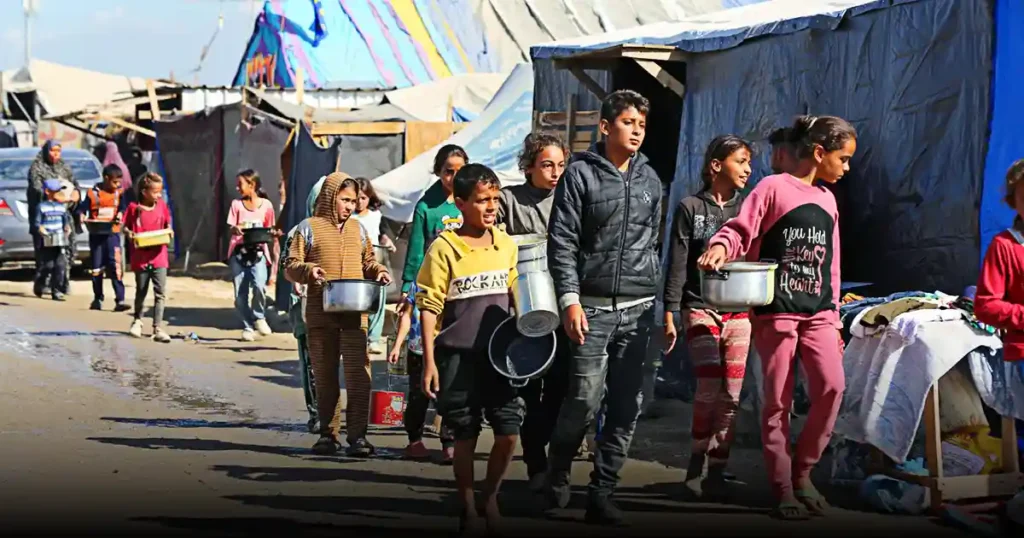In a sobering reminder of humanity’s challenges, the World Food Programmed (WFP) has issued an urgent appeal for $16.9 billion to combat escalating global hunger in 2025. With food insecurity worsening due to conflicts, climate change, and economic instability, this funding request underscores the dire situation confronting millions worldwide.
This article delves into the causes, consequences, and potential solutions to the hunger crisis, emphasizing why collective action is imperative to address this humanitarian emergency.
Understanding the Global Hunger Crisis

Hunger, at its core, is more than just a lack of food; it’s a multidimensional issue impacting health, economic stability, and societal well-being. According to recent reports, over 735 million people worldwide faced chronic hunger in 2023, a number that continues to rise.
Key Facts and Figures
- Chronic Hunger: Nearly 1 in 10 people globally suffer from undernourishment.
- Severe Food Insecurity: Over 2.4 billion people lack consistent access to nutritious and sufficient food.
- Children at Risk: Malnutrition causes nearly 45% of deaths among children under five.
Root Causes of the Hunger Crisis
1. Conflict and Displacement
War and violence disrupt food production, destroy infrastructure, and displace millions.
- Examples:
- In Yemen, prolonged conflict has left millions on the brink of famine.
- In Sudan, ongoing violence has worsened food insecurity for displaced populations.
2. Climate Change
Extreme weather events, prolonged droughts, and rising temperatures are devastating agriculture.
- Impact:
- Farmers face crop failures, reduced yields, and loss of arable land.
- Regions like the Horn of Africa are grappling with recurring droughts, pushing communities into crisis.
3. Economic Instability
Global economic disruptions, inflation, and unemployment exacerbate hunger.
- Examples:
- The COVID-19 pandemic deepened poverty and reduced access to food.
- Rising food prices due to geopolitical tensions, like the Ukraine war, have strained food supply chains.
4. Inequality and Poverty
Hunger is disproportionately felt by marginalized communities with limited resources.
- Statistics:
- Rural populations often face higher rates of food insecurity than urban counterparts.
- Women and children are particularly vulnerable, with women often eating last and least.
Consequences of the Hunger Crisis
1. Health Impacts
- Malnutrition:
Undernourishment weakens immune systems, making individuals more susceptible to diseases. - Stunting and Wasting:
Children deprived of adequate nutrition suffer long-term physical and cognitive impairments.
2. Economic Strain
- Hunger reduces productivity, impacting individual livelihoods and national economies.
- Malnutrition-related healthcare costs place additional burdens on already strained systems.
3. Social Unrest and Instability
- Food insecurity often leads to unrest, as seen in countries where food shortages spark protests.
- Political instability is exacerbated in regions unable to meet the basic needs of their populations.
The World Food Programme’s Appeal
The WFP’s request for $16.9 billion aims to address immediate needs while investing in sustainable solutions:
Key Objectives of the Appeal
- Emergency Relief:
Provide food aid to the most vulnerable populations in conflict and disaster zones. - Nutrition Programs:
Focus on malnourished children, pregnant women, and nursing mothers to break the cycle of hunger. - Resilience Building:
Support smallholder farmers with resources, training, and access to markets. - Innovative Solutions:
Leverage technology, such as blockchain and digital platforms, to enhance food distribution efficiency.
Funding Breakdown
- Emergency Response: 60% of the budget will go toward life-saving interventions.
- Development Programs: 40% will support long-term initiatives to tackle the root causes of hunger.
What Needs to Be Done? Global Solutions to Hunger
1. Strengthening Global Cooperation
- Partnerships:
Governments, NGOs, and private sectors must collaborate to fund and implement hunger alleviation programs. - Policy Reforms:
International policies should address trade barriers and ensure fair distribution of food resources.
2. Investing in Sustainable Agriculture
- Climate-Resilient Practices:
Promote drought-resistant crops and sustainable farming techniques. - Infrastructure Development:
Build better irrigation systems, storage facilities, and transportation networks.
3. Harnessing Technology
- Digital Tools:
Use satellite data and AI to predict food shortages and optimize resource allocation. - Blockchain for Transparency:
Ensure accountability in food distribution through decentralized systems.
4. Empowering Communities
- Education and Awareness:
Train communities on nutrition, food preservation, and sustainable practices. - Gender Equality:
Support women farmers and ensure equitable access to resources.
The Role of Individuals in Combating Hunger
Raise Awareness
Use social media, blogs, and local platforms to highlight the issue and advocate for change.
Support Charitable Organizations
Donate to reputable organizations like the WFP, Feeding America, or Action Against Hunger.
Reduce Food Waste
Be mindful of consumption habits and support initiatives that redistribute surplus food to those in need.
Volunteer Locally
Engage with community programs that address hunger, such as food banks and meal distribution drives.
A Call to Action: Why 2025 Is a Turning Point
The hunger crisis is not an isolated problem; it affects everyone by destabilizing societies and limiting global progress. The WFP’s appeal for $16.9 billion is not just about feeding the hungry—it’s about securing a future where no one goes to bed hungry.
As the world stands at a crossroads, it is essential for governments, organizations, and individuals to act decisively. Together, we can transform the hunger crisis into an opportunity for resilience, growth, and humanity.
This comprehensive analysis provides an engaging and informative look at the global hunger crisis, encouraging readers to reflect on their role in addressing this critical issue.






